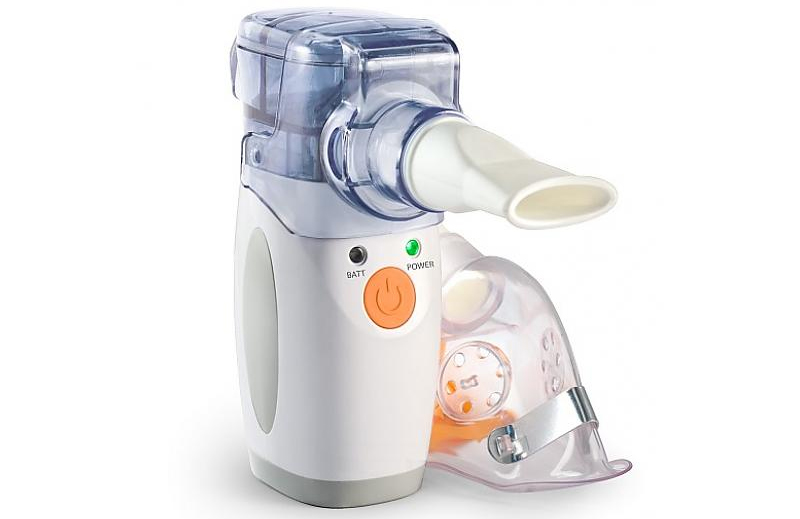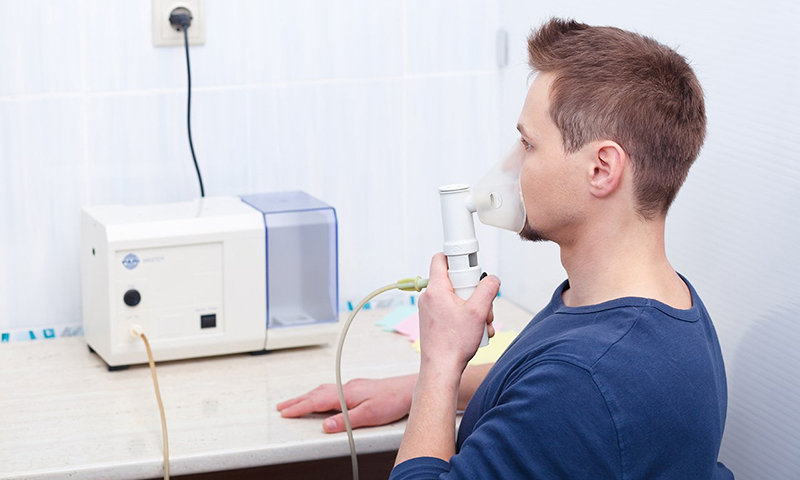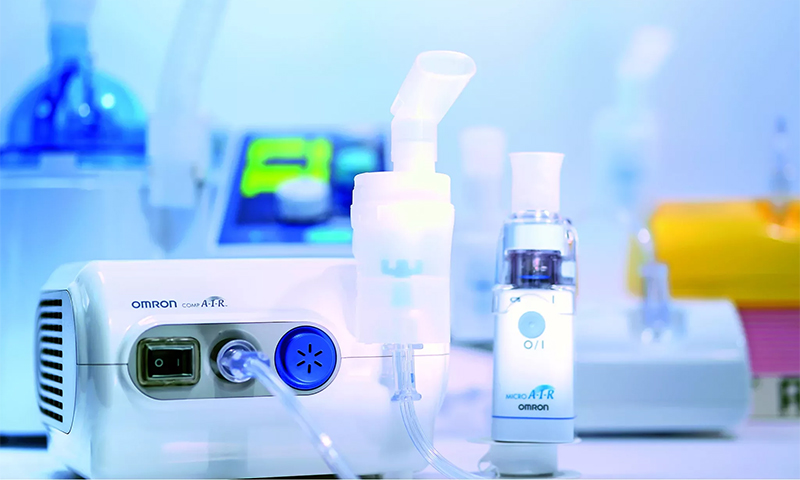Any respiratory diseases - from the common cold to pneumonia - are most effectively treated with inhalation. Previously, for this, you had to go to the clinic every day or sit over a saucepan with hot herbal decoction. Now for fast delivery of drugs directly to the bronchi and lungs, it is enough to get a good nebulizer inhaler. It does not boil anything and does not heat up; therefore, the nutrients in infusions and pharmaceutical preparations are completely preserved. You just have to breathe for 5-10 minutes with a healing “fog”, and after a few procedures, the disease will recede.

Content:
The best manufacturers of nebulizers - which company to choose
There are a lot of companies producing medical nebulizers in our market. In pharmacies, you can find models of both domestic and foreign production. But not all firms get really good devices for "cold" inhalation.
The most efficient and reliable devices are produced by European and Japanese manufacturers:
- Omron;
- B.Well;
- Microlife;
- MED 2000.
In our area, only subsidiaries of famous brands successfully work in this direction: AnD RUS and Little Doctor International. Their products are of high quality, functionality and trouble-free operation (with proper handling of devices).
The best nebulizers released under these brands are represented in our rating. If you know exactly which inhaler you need, you can freely choose from among them any suitable model.
Those who have never encountered such devices before should first learn the features of their work and the main characteristics.
The principle of operation and the device nebulizer

By design, the nebulizer is not much different from the usual inhaler, although its principle of operation is somewhat different. There is no heating of drugs, no evaporation - the liquid turns into an aerosol due to mechanical action.
Passing through a vibrating spray or under the pressure of a powerful jet of air, the solutions are broken into tiny droplets and at the exit form a cloud of medicinal mist suitable for breathing.
The main parts of any nebulizer:
1. Housing;
2. Tank for drugs with a volume of 7 to 150 ml;
3. Suction and supply hoses with damper;
4. Mouthpiece or mask for inhalation;
5. Spray.
Types of nebulizers
Ultrasound

Such devices rather finely disperse liquid preparations, yielding particles up to 5 microns in size. This is enough for the medicine to be able to get even into hard-to-reach areas of the bronchi. The very process of turning a solution into mist is due to the vibration of metal plates, creating a high-frequency ultrasonic flow.
Such models can operate continuously for about 5-10 minutes, because they have a relatively small capacity for drugs (35-70 ml) and a high feed rate of up to 2 ml / min. They weigh at least 400-500 grams, and the noise level of such devices does not exceed 45 dB.
Ultrasonic nebulizers can operate on a 220 V mains, built-in battery or conventional batteries. They are suitable for the treatment of asthma, rhinitis, cough, bronchitis and other common respiratory diseases.
Pros:
- A wide range - from compact portable models on batteries to stationary devices;
- Effectively deliver drugs to the bronchi;
- Can be used to treat children;
- High speed aerosol spraying;
- Affordable cost.
Minuses:
- Do not work with herbal decoctions and solutions of essential oils;
- Tanks for drugs require frequent replacement.
Compressor (stock)

These nebulizers work at the expense of a powerful stream of compressed air that turns a liquid into a fog with a particle size of about 4-5 microns. The main feature of such devices is that they can be poured any medications - without any restrictions. Alas, there were some drawbacks too.
Compressor nebulizers turned out to be very cumbersome: here, even with the smallest model, overall dimensions reach 115x185x135 mm, and their weight is 1.5 kg. Standard devices are approximately twice as large.
But stock inhalers are considered more comfortable and durable compared to other types of nebulizers. The volume of their tank reaches 100-150 ml, which means that it will be necessary to refill the device much less often.
With the help of compressors, tuberculosis and other severe lung diseases can be treated, and they can cope with a common cold without difficulty.
Pros:
- High efficiency procedures;
- Can be used with any drugs;
- Reliable and durable;
- Suit even babies.
Minuses:
- Expensive;
- Bulky and heavy.
Membrane

Mesh nebulizers - a new word in the world of inhalers. Here, the perforated vibrating membrane is responsible for the spraying of drugs, through the holes of which the solution “squeezes”, turning into an aerosol cloud. Moreover, the fluid particles are so small that they easily reach even the pulmonary alveoli.
Membrane inhalers are the most compact, lightweight and convenient to use, since their weight does not exceed 120-150 grams. Despite its miniature size and small capacity of the built-in tank for 7-15 ml, mesh nebulizers are able to work for several hours. They are very economical to use drugs, so that one filling is not enough for one inhalation session.
The mesh devices can be used both for adults and children, and thanks to their compact size, it is convenient to take them with you on trips or carry them in your pocket (which is especially important for people suffering from allergies or asthma).
Pros:
- Maximum efficiency and range of drug delivery;
- Compact size and low weight;
- Very quiet operation (15-20 dB);
- Economical consumption of drugs;
- You can use any drugs.
Minuses:
- High price;
- They require careful handling, especially if you carry a nebulizer in your pocket.
Nebulizer selection options

Degree of spraying
The smaller the size of the particles in the composition of the drug mist, the deeper they will be able to penetrate into the respiratory system.
This is what determines the effectiveness of the inhaler. Most nebulizers have a sputtering rate of about the same and is about 5 microns - this is enough to treat any diseases of the upper respiratory tract, trachea, bronchi and bronchioles.
The exception is membrane inhalers, for which the size of fog droplets does not exceed 3-4 microns (usually it is even smaller). So if the treatment should affect not only the bronchi, but also the lungs, it is better to choose a mesh-nebulizer.
Aerosol Feed Mode
There are several main modes of supplying steam to an inhaler mask or mouthpiece:
1. Continuous - the most inefficient option, when the aerosol is supplied continuously, regardless of whether the patient breathes. As a result, most of the drug is simply lost, and only 20-30% of the drug mist reaches its destination.
2. With manual control - here the process of vaporization also occurs continuously, but in contrast to the previous method, a person can independently block the supply of aerosol with one touch of a button. This allows you not to waste the solution in vain, but only an adult can manage the nebulizer manually - you cannot explain to a child that you need to press a button while inhaling and let it go when you exhale.
3. Automatic - forms a drug cloud only at the moment of inhaling the patient and blocks the flow of steam on the exhale.This happens due to special electronic sensors and valves, which minimize the loss of fluid during the procedure.
Volume
Choosing the capacity of the tank, you will encounter the fact that for each type of nebulizer the volume of the medicine tank fits into its rather narrow range:
1. For ultrasound models, 50-70 ml is the norm. There is no need to look for more, and if you take less, one refill may not be enough for the procedure.
2. For compressor models, the tank should be at least 100 ml, as these are powerful devices, often allowing for overruns of drugs. A large tank will help compensate for this deficiency and provide the respiratory organs with the required amount of the drug.
3. In mesh models, very small tanks of up to 15 ml are installed. Despite this, they are enough for several full-fledged sessions due to a more economical solution consumption.
Looking for a tank for your needs, you actually choose one or another type of nebulizer. For example, if you often have to inhale all households, you will need a large capacity for medicines, which means it will be a compressor model.
For personal use and the reception of potent means enough miniature tank - these are used in ultrasound and mesh devices.
Spraying speed
The higher this figure is for the chosen model of nebulizer, the faster it will ship the entire dose of medication to the respiratory tract, speeding up the procedure.
1. For most adults, this does not matter much, so a low-powered model operating at a rate of 0.25–0.5 ml / min is enough for them.
2. It is better for small patients to shorten the time spent at the device by selecting an inhaler with a feed rate of about 1-2 ml / min
Noise level
Of course, the quieter the nebulizer works, the more comfortable the procedure will be.
1. If this is important for you, choose quiet meshes - they give no more than 20 dB.
2. Ultrasonic inhalers louder: their noise performance reaches 40-45 dB.
3. Compressor models are the most “ringing” - these are capable of producing sounds of 45-55 dB.
Autonomy
Nebulizers can operate not only from the network, but also from the built-in battery or batteries. Moreover, manufacturers often offer combined methods of nutrition, which makes the use of such inhalers even more convenient.
However, the presence of such "buns" increases the cost of a portable device, so you have to decide which is more important: the possibility of battery life or an affordable price.
What kind of nebulizer to choose

1. If you need a reliable inhaler for the treatment of complex respiratory diseases, you need a powerful compressor unit with a large tank (not less than 100 ml) and a particle size of 3-5 microns to be blown out.
2. Allergy sufferers, asthmatics and people with other chronic respiratory diseases should get a compact mesh nebulizer on batteries with a high sputtering rate (up to 2 ml / min). It can always be kept with you and used if necessary, immediately receiving a loading dose of drugs.
3. Good help in the cold season will be an inexpensive ultrasonic nebulizer. If you plan to treat with the help of all households, buy a model with a capacious 70 ml tank and additional “childish” nozzles.
How much is a nebulizer

1. Ultrasonic nebulizer of domestic production can be purchased at a price of 2-2.4 thousand rubles. Advanced foreign models reach 3.5-5 thousand.
2. Compressor inhaler will cost you in the amount of from 1700-1800 rubles to 10.5-11.5 thousand - it all depends on the popularity of the manufacturer and the main characteristics of the device.
3. Mesh inhalers are priced from 3 to 12 thousand rubles.
It will be interesting to friends too



